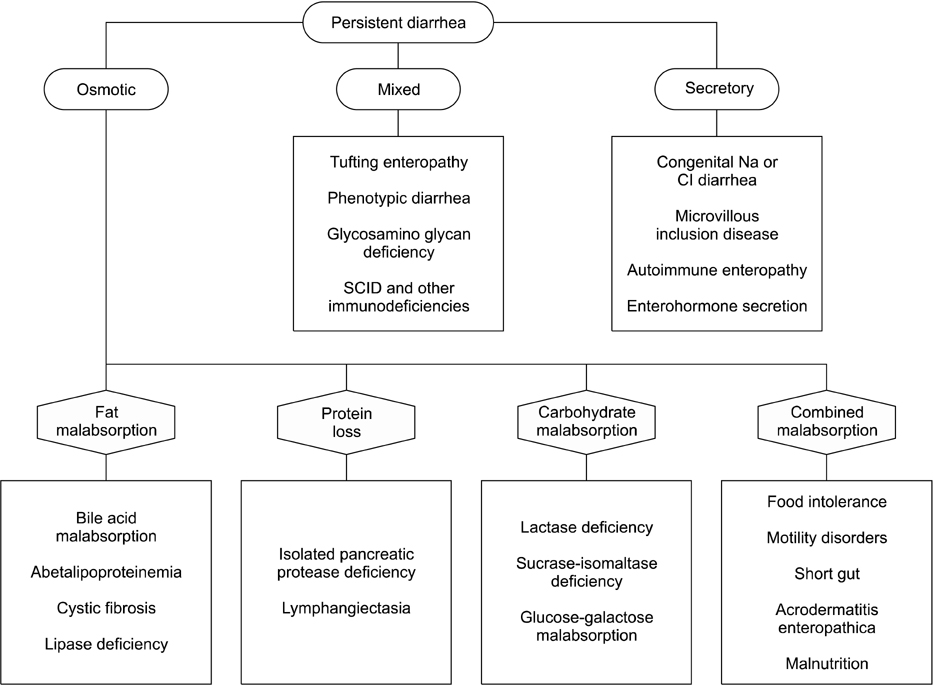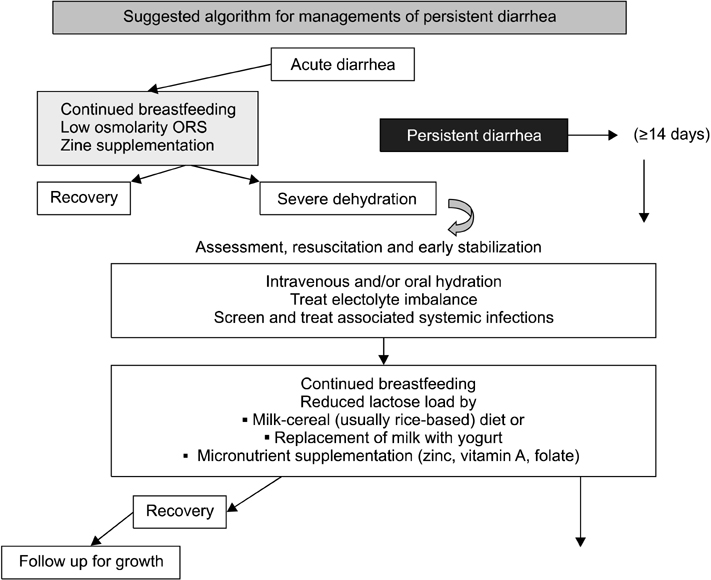Pediatr Gastroenterol Hepatol Nutr.
2012 Dec;15(4):229-236.
How to Do in Persistent Diarrhea of Children?: Concepts and Treatments of Chronic Diarrhea
- Affiliations
-
- 1Department of Pediatrics, College of Medicine, Dankook University, Cheonan, Korea. pdlks@dankook.ac.kr
Abstract
- Chronic diarrhea is defined as passing watery stools that lasts for more than 2 weeks. Persistent diarrhea belongs to chronic diarrhea and is a chronic episode of diarrhea of infectious etiology. The etiology of chronic diarrhea is varied. It is important to consider the child's age and clinical manifestations with alarm signals for an application of proper treatments to children with chronic diarrhea. Vicious cycle is present in chronic diarrhea and nutritional rehabilitation can break the vicious cycle of chronic diarrhea and is one of the main one thing among treatments. We should know the exact concept of chronic diarrhea and provide appropriate treatments according to etiologies of chronic diarrhea.
Keyword
Figure
Reference
-
1. Kliegman RM, Stanton BF, St. Geme JW 3rd, Schor NF, Behrman RE. Nelson textbook of pediatics. 2011. 19th ed. Philadelphia: Saunders Elsevier;1339–1346.2. Wardlaw T, Salama P, Brocklehurst C, Chopra M, Mason E. Diarrhoea: why children are still dying and what can be done. Lancet. 2010. 375:870–872.
Article3. Bhutta ZA, Ghishan F, Lindley K, Memon IA, Mittal S, Rhoads JM. Commonwealth Association of Paediatric Gastroenterology and Nutrition. Persistent and chronic diarrhea and malabsorption: Working Group report of the second World Congress of Pediatric Gastroenterology, Hepatology, and Nutrition. J Pediatr Gastroenterol Nutr. 2004. 39:Suppl 2. S711–S716.
Article4. Weaver LT. Bowel habit from birth to old age. J Pediatr Gastroenterol Nutr. 1988. 7:637–640.
Article5. Mathai J, Raju B, Bavdekar A. Pediatric Gastroenterology Chapter, Indian Academy of Pediatrics. Chronic and persistent diarrhea in infants and young children: status statement. Indian Pediatr. 2011. 48:37–42.
Article6. Zella GC, Israel EJ. Chronic diarrhea in children. Pediatr Rev. 2012. 33:207–217.
Article7. Hwang JB, Kang KJ, Lee JJ, Kim AS. What is the 'objective' differential factor of diarrhea in infancy?: Normal state versus diarrheal illness in infants with chronic frequent and loose stool. Korean J Pediatr. 2010. 53:1006–1011.
Article8. Lee KS, Lee JH. Clinical applications and limitations of a special formula for diarrhea in children. J Korean Med Assoc. 2012. 55:551–561.
Article9. Walker-Smith JA. Intractable diarrhea of infancy. Saudi J Gastroenterol. 1995. 1:152–156.10. Kleiman RE, Goulet O, Mieli-Vergani G, Sanderson IR, Sherman PM, Shneider BL. Walker's pediatric gastrointestinal disease: physiology, diagnosis, management. 2008. 5th ed. Hamilton: BC Decker Inc.;265–339.11. Wyllie R, Hyams JS, Kay M. Pediatric Gastrointestinal and Liver disease. 2011. 4th ed. Philadelphia: Saunders Elsevier;106–118.12. Guerrant RL, Oriá RB, Moore SR, Oriá MO, Lima AA. Malnutrition as an enteric infectious disease with long-term effects on child development. Nutr Rev. 2008. 66:487–505.
Article13. Lasekan JB, Jacobs J, Reisinger KS, Montalto MB, Frantz MP, Blatter MM. Lactose-free milk protein-based infant formula: impact on growth and gastrointestinal tolerance in infants. Clin Pediatr (Phila). 2011. 50:330–337.
Article14. Mao M, Yu T, Xiong Y, Wang Z, Liu H, Gotteland M, et al. Effect of a lactose-free milk formula supplemented with bifidobacteria and streptococci on the recovery from acute diarrhoea. Asia Pac J Clin Nutr. 2008. 17:30–34.15. Heubi J, Karasov R, Reisinger K, Blatter M, Rosenberg L, Vanderhoof J, et al. Randomized multicenter trial documenting the efficacy and safety of a lactose-free and a lactose-containing formula for term infants. J Am Diet Assoc. 2000. 100:212–217.
Article16. Nizami SQ, Bhutta ZA, Molla AM. Efficacy of traditional rice-lentil-yogurt diet, lactose free milk protein-based formula and soy protein formula in management of secondary lactose intolerance with acute childhood diarrhoea. J Trop Pediatr. 1996. 42:133–137.
Article17. de Mattos AP, Ribeiro TC, Mendes PS, Valois SS, Mendes CM, Ribeiro HC Jr. Comparison of yogurt, soybean, casein, and amino acid-based diets in children with persistent diarrhea. Nutr Res. 2009. 29:462–469.
Article18. Bhutta ZA, Nelson EA, Lee WS, Tarr PI, Zablah R, Phua KB, et al. Persistent Diarrhea Working Group. Recent advances and evidence gaps in persistent diarrhea. J Pediatr Gastroenterol Nutr. 2008. 47:260–265.
Article19. Lake AM. Beyond hydrolysates: use of L-amino acid formula in resistant dietary protein-induced intestinal disease in infants. J Pediatr. 1997. 131:658–660.20. Chehade M, Magid MS, Mofidi S, Nowak-Wegrzyn A, Sampson HA, Sicherer SH. Allergic eosinophilic gastroenteritis with protein-losing enteropathy: intestinal pathology, clinical course, and long-term follow-up. J Pediatr Gastroenterol Nutr. 2006. 42:516–521.21. Lukacik M, Thomas RL, Aranda JV. A meta-analysis of the effects of oral zinc in the treatment of acute and persistent diarrhea. Pediatrics. 2008. 121:326–336.
Article
- Full Text Links
- Actions
-
Cited
- CITED
-
- Close
- Share
- Similar articles
-
- Chronic nonspecific diarrhea of children
- Gaps between Infant Diarrheal Disease and Frequent Loose Stool
- Diagnosis and Management of Chronic Diarrhea
- Clinical applications and limitations of a special formula for diarrhea in children
- A Case of Chronic Diarrhea after Neurolytic Celiac Plexus Block: A case report






